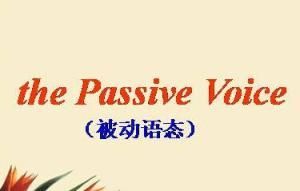結構
英語被動語態的構成通常是:“be+done”。但“get+done”也可以構成被動語態,用這種結構的句子側重於動作的結果而不是動作本身。如: The man got hurt on his way home. 那個男人在回家的路上受傷了。 How did the glass get broken? 杯子怎么破了?
例如:Chinese is spoken by many people. 中文Chinese是動詞speak的承受者。被例如中文常說:我被他打,這就是一種被動。但有時由於句子結構上的需要也要用被動,例如It is not unusual for workers in that region to be paid more than a month it 在句中作形式主語。而不定式to be paid more than a month是句子的邏輯主語。結合選項全句的意思是:“那個地方的工人一個多月後才得到工資是常有的事”。
語法要點
當主動語態要被改成被動的時候,我們把原句的賓語提前,作為該句的主語,主語後置,作為賓語。因此有一點要注意,不及物動詞由於不加賓語,沒有被動形式,但不及物動詞如果與某些介詞構成介詞短語,可以用被動。例如The fire had been put out before the fireman arrived. Put在此處是不及物動詞,但put out是及物動詞。
| TENSE | 主動語態 | 被動語態 |
| 一般現在時 | be+V.\V.s | am\is\are+(p.p) |
| 一般將來時 | will\be going to | will be +(p.p) |
| 現在進行時 | am\is\are+V.ing | am\is\are+being+(p.p) |
| 一般過去時 | ①was\were②V.ed | was\were+(p.p) |
| 現在完成時 | have\has+V.p.p | have\has+been+(p.p) |
| 過去完成時 | had+V.p.p | had+been+(p.p) |
| 過去進行時 | was\were+V.ing | was\were+being+(p.p) |
| 情態動詞 | 情態動詞+V. | 情態動詞+be+(p.p) |
句型概述
①(,一般將來時):am, is, are, was, were, is going to be , will be+done . 例如: Once environmental damage is done, it takes many years for the system to recover. 本句的意思是:“環境一旦遭到破壞,需要多年時間才能恢復過來。”do作為及物動詞有“引起,產生”的含義,do damage的意思是“造成破壞”。主語damage是及物動詞do的動作對象,謂語應當用被動語態。
④ 其他時態以此類推,可得到結果。
⑤情態動詞的被動語態:主語 + 情態動詞 + be動詞 + 動詞過去分詞,例如Your teeth must be brushed.
⑥不定式的被動語態:to be done例:The no-shows have to be considered when deciding the rate of overbooking.(確定超過接待能力的預定時必須考慮預定了房間卻來不了的客人。
特殊情況
① 有些動詞在主動結構中,後面接不帶to的不定式,但如果改為被動,則需把省略的to加上,這類動詞有 [let, make, have,help]和感官動詞[feel,see,hear,watch,look at,listen to],如:The boss made my grandfather work 10hours a day.改成My grandfather was made to work for 10 hours a day.
② 含有賓語從句的主動結構變為被動,通常用it作為被動結構的先行主語,從句放在句子後面/也可採用另一種形式,這類動詞有:know, say, believe, find, think, report等
③ 不是所有的主動句都可以變換成被動句,更不是所有的被動句都可以自由變換成主動句。雖然語法原則上允許主動和被動句的互相轉換,但有的句子轉換後會變成不通順或不地道的英語句子。因此,在某些題目里,這也成為判斷應該用主動還是用被動的依據。
例:At 5:05 p.m. on Saturday 19th July , there was an accident at the junction of the Main Street and Panda Road when a boy was knocked down off his bicycle by a delivery van. The boy was sent to St. Maria Hospital where he was treated for shock and a broken arm.
在這段文章里,a boy was knocked down off his bicycle by a delivery van這句被動句強調出讀到文章的人最關心的事故的受害者。The boy was sent to St. Maria Hospital這句話則說明了孩子被送到醫院的事實,至於是由誰(某個過路人?或肇事司機?)送的不重要。he was treated for shock and a broken arm這句被動句無須說出treat這個動作的發出者,因為在醫院,傷病員自然由醫務人員處理,無須囉嗦。這樣,這段文章就重點突出,條理清楚了。
④ 有些動詞可以有兩個賓語,在用於被動結構時,可以把主動結構中的一個賓語變為主語,另一個賓語仍然保留在謂語後面。多是把間接賓語變為主語。這樣句子自然些。直接賓語變為主語時,間接賓語要變為某個介詞的賓語,介詞to可以省略。如His father left him this house.改為This house was left (to) him by his father.
⑤ 有些動詞雖為及物,但賓語並非是動作承受者,不能轉換,這些動詞有have, hold(容納),suit, fit, lack, become(適合)contain, cost, last, mean, suffice(足夠)等。
⑥ 當直接賓語為反身代詞、相互代詞或賓語前有指代主語的物主代詞時不用被動,如I shook my head.我搖搖頭。
⑦ 當賓語為同源賓語(與主句指同一人),動名詞,動詞不定式或一個從句時不用被動。如John enjoyed seeing the fil,.
⑧ 在一些固定說法中,有些名詞和動詞結合的固定說法,不能改We Chinese always keep our word.
⑨ 某些從不及物動詞轉化來的及物動詞,直接賓語在表示動作的方式或效果時,這些動詞在意思上起狀語的作用,沒有被動The girl kissed her boyfriend good night=The girl said good night to her boyfriend by kissing him.(這個女孩說了晚安並且親了他的男朋友)
⑩ 表地點\處所\組織\長度\大小\數量\程度\抽象名詞的詞做賓語時不用被動.
⑪ 某些“不及物動詞+介詞”短語walk into, listen to, sleep in, agree with, shake hands with, belong to, take part in, keep up with不能用被動。
⑫ 某些詞用主動表被動:sell, miss, build, grow, smell, taste, sound, feel等
時態
1.一般現在時的被動語態構成:is / am / are + 及物動詞的過去分詞
Our classroom is cleaned everyday.
I am asked to study hard.
Knives are used for cutting things.
2.一般過去時的被動語態構成:was / were + 及物動詞的過去分詞
A new shop was built last year.
Dinosaur eggs were laid long long ago.
3.現在完成時的被動語態構成:has / have + been +及物動詞的過去分詞
This book has been translated into many languages.
Many man-made satellites have been sent up into space by many countries.
4.一般將來時的被動語態構成:will/shall+ be + 及物動詞的過去分詞
A new hospital will be built in our city.
Many more trees will be planted next year.
5.含有情態動詞的被動語態構成:情態動詞+ be + 及物動詞的過去分詞
Young trees must be watered often.
Your mistakes should be corrected right now.
The door may be locked inside.
Your homework can be handed in tomorrow.
6.現在進行時的被動語態構成:am / is / are + being +及物動詞的過去分詞
Uncle Wang is mending my bike now.→
My bike is being repaired by Tom now.
They are planting trees over there. →
Trees are being planted over there by them.
7.不定式的被動語態:to + be + 及物動詞的過去分詞
There are two books to be read. →
There are twenty more trees to be planted.
8.過去將來時的被動語態:would /should+ be + 及物動詞的過去分詞
He said he would finish the work soon.
He said the work would be finished soon by him.
變換規則
把主動語態改為被動語態非常簡單,可以遵循以下幾個步驟:
1. 先找出謂語動詞;
2. 再找出謂語動詞後的賓語;
3. 把賓語用作被動語態中的主語;
4. 注意人稱、時態和數的變化。
例:1. Bruce writes a letter every week. →A letter is written by Bruce every week.
2. Li Lei mended the broken bike this morning.→The broken bike was mended by Li Lei this morning.
3. He has written two novels so far.→Two novels have been written by him so far.
4. They will plant ten trees tomorrow.→Ten trees will be planted by them tomorrow.
5. Lucy is writing a letter now.→A letter is being written by Lucy now.
6. You must lock the door when you leave.→the door must be locked when you leave.
新興形式
Get+過去分詞也可以構成被動語態,用這種結構的句子側重於動作的結果而不是動作本身。如: The man got hurt on his way home. 那個男人在回家的路上受傷了。 How did the glass get broken? 杯子怎么破了?
著名學者周海中教授在論文《Get-Passive研究》中指出:Get+過去分詞的被動語態是一種新興的被動語態形式;相對來說它的使用還沒有Be+過去分詞構成的被動語態那么廣泛,一般限於口語和非正式書面語;但它卻有著用得愈來愈多的趨勢,是一種生氣蓬勃的語言現象。

